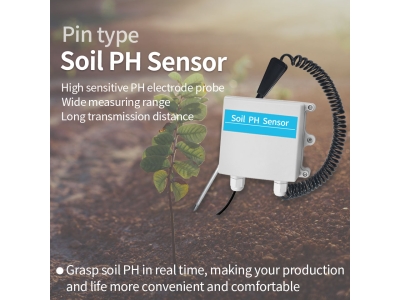Introduction In recent years, the agricultural industry has been facing numerous challenges, including climate change, soil degradation, and water scarcity. These challenges have led to a growing demand for sustainable farming practices that can help ensure food security for future generations. One of the key tools in achieving this goal is the use of soil sensors, which play a crucial role in monitoring and managing soil health and fertility. In this article, we will explore the role of soil sensors in sustainable farming practices and their potential to revolutionize the way we cultivate tomorrow's crops.

The Importance of Soil Health Soil health is a critical factor in determining the productivity and sustainability of agricultural systems. Healthy soil provides essential nutrients to plants, supports diverse microbial communities, and helps regulate water and nutrient cycles. However, modern agricultural practices, such as intensive tillage, chemical fertilization, and monocropping, have led to widespread soil degradation and loss of fertility. As a result, farmers are increasingly turning to sustainable farming practices that prioritize soil health and conservation.
Soil Sensors: Monitoring and Managing Soil Health Soil sensors are a valuable tool for monitoring and managing soil health. These devices measure various soil parameters, such as moisture content, temperature, pH, and nutrient levels, providing farmers with real-time data on the condition of their fields. By using this information, farmers can make informed decisions about irrigation, fertilization, and crop rotation, leading to more efficient and sustainable farming practices.
For example, soil moisture sensors can help farmers optimize irrigation schedules, reducing water waste and the risk of waterlogging or drought stress. Similarly, nutrient sensors can provide precise information on soil fertility, allowing farmers to apply fertilizers more efficiently and minimize nutrient runoff. By integrating soil sensors into their management practices, farmers can improve crop yields, reduce input costs, and minimize their environmental impact.
The Potential of Soil Sensors in Sustainable Agriculture The use of soil sensors has the potential to revolutionize the way we approach agriculture. By providing farmers with accurate, real-time data on soil conditions, these devices can help optimize resource use, reduce environmental impact, and improve overall farm productivity. In addition, soil sensors can also contribute to the development of precision agriculture, where farming practices are tailored to the specific needs of individual fields or even individual plants.
Furthermore, soil sensors can play a crucial role in climate change mitigation and adaptation. By helping farmers monitor and manage soil carbon levels, these devices can contribute to the sequestration of carbon in agricultural soils, helping to mitigate the effects of climate change. Additionally, by providing early warning of soil degradation and nutrient depletion, soil sensors can help farmers adapt to changing climatic conditions and ensure the long-term sustainability of their agricultural systems.
Challenges and Opportunities While soil sensors offer numerous benefits for sustainable farming practices, their widespread adoption still faces several challenges. One of the main barriers is the cost of these devices, which can be prohibitive for small-scale farmers. Additionally, there is a need for further research and development to improve the accuracy and reliability of soil sensors, as well as to develop user-friendly interfaces and data management systems.
However, despite these challenges, there are also significant opportunities for the future of soil sensors in agriculture. Advances in sensor technology, data analytics, and machine learning are making these devices more affordable, accurate, and accessible. Furthermore, there is a growing recognition of the importance of soil health in sustainable agriculture, leading to increased support for research and innovation in this field.
Conclusion In conclusion, soil sensors play a crucial role in sustainable farming practices by providing farmers with real-time data on soil health and fertility. By using this information, farmers can make informed decisions about irrigation, fertilization, and crop management, leading to more efficient and sustainable agricultural systems. As the agricultural industry continues to face the challenges of climate change, soil degradation, and water scarcity, the use of soil sensors has the potential to revolutionize the way we cultivate tomorrow's crops, ensuring food security for future generations.






